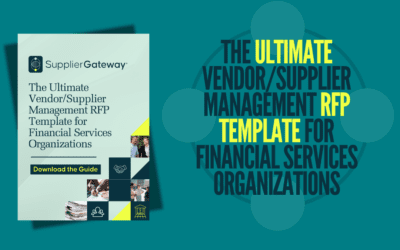All relationships, professional or otherwise, eventually come to an end. This includes relationships with your suppliers as well. While breakups are never fun or easy, there are strategic ways to end relationships with suppliers that can help your company reduce risk in the long run.
This is where supplier offboarding comes into play.
To put supplier offboarding into perspective, imagine you’ve decided to stop using a particular credit card altogether. The interest rate is too high, the fees are ridiculous, and using the card is more trouble than its worth. You take the card out of your wallet and throw it in the trash, but you don’t bother to destroy the card before throwing it away, and you don’t call the credit card company to close your account.
Is that how you’d go about ending a relationship with a credit card company? Not if you’re interested in protecting your financial security.
So why would ending a relationship with a supplier to your company be any different?
But this is exactly what most companies do; they simply stop buying goods or services from suppliers they no longer wish to do business with.
Just because you’ve stopped buying from a supplier does not mean that you’ve ended your relationship, and your company may still be on the hook regarding financial, legal, and other types of risk.
Because supplier offboarding is a newer concept regarding risk mitigation and management, we wanted to offer an easy-to-understand framework that will help your company establish best practices when starting a new supplier offboarding program.
What is Supplier Offboarding and How Does It Help My Company?
Supplier offboarding refers to the steps a company takes when ending a partnership with a supplier. The goal is to ensure all obligations to a supplier are fulfilled and any risks from that supplier are properly mitigated.
An effective offboarding program should cover a few key areas:
- Contracts: Review contracts and ensure your obligations are met. Make sure you are not on the hook for any supplier liabilities.
- Assets: Determine what, if any, physical assets the supplier has that belong to you. Equipment, inventory, or intellectual property are examples of assets. Make arrangements to get those back, and have a documented paper trail.
- Data: Ensure all company data is removed from supplier systems. You don’t want sensitive data lingering after the partnership ends.
- Processes: Update any internal processes, systems, and tools that involved that supplier. Remove their access and information.
- Communications: Formally communicate the end of the partnership to relevant teams and stakeholders. Make sure everyone is on the same page about the offboarding.
- Audits: Consider doing an audit of the offboarding process to ensure everything was properly completed and documented. This helps you improve future offboarding programs.
Benefits of Supplier Offboarding
When done correctly, supplier offboarding has several benefits:
- Risk management: Offboarding suppliers that pose potential risks helps protect your company from reputational damage, legal issues, and financial losses.
- Cost savings: Terminating relationships with underperforming or expensive suppliers can lead to cost savings by lowering the cost associated with managing them or by switching to more cost-effective alternatives.
- Improved supplier portfolio: Offboarding allows you to refine your supplier portfolio by focusing on high-performing and reliable suppliers. This improves the overall quality of your supply chain and helps your organization to achieve its strategic goals.
- Enhanced performance: Offboarding underperforming suppliers and replacing them with more efficient ones can lead to improved performance in terms of product quality, delivery times, and customer satisfaction.
- Better resource allocation: By offboarding suppliers that no longer meet your organization’s needs, you can redirect resources toward more strategic partnerships and initiatives that align with your business objectives.
- Continuous improvement: The offboarding process, including exit interviews and performance evaluations, can provide valuable insights into areas where your organization’s supplier management processes can be improved.
- Stronger relationships with remaining suppliers: By maintaining a smaller, more focused supplier base, you can foster stronger relationships and collaboration with your remaining suppliers, leading to better overall performance and results.
- Clear message to other suppliers: Having a supplier offboarding program communicates to suppliers that your company is committed to maintaining high standards. This can encourage them to continually improve their performance to maintain their partnership with your company.
Playing Fast and Loose: The Risks of Not Having a Supplier Offboarding Program
Setting up a supplier offboarding program will take some time, but the benefits far outweigh the time expenditure involved. Incorrectly ending relationships with suppliers opens your organization up to all sorts of risks.
Do you really want to play it fast and loose with potential litigation and financial loss?
Here’s a list of the risks your company may face should you choose to forgo a supplier offboarding program:
- Legal disputes: Failing to follow contractual obligations or adhere to termination clauses can result in legal disputes that are costly, time-consuming, and can result in reputational damage for your company.
- Financial losses: Inadequate offboarding can lead to unresolved financial matters, such as outstanding payments or refunds. This can create financial losses and strain the relationship between your organization and the supplier.
- Operational disruptions: Improperly changing over responsibilities and resources can lead to disruptions in your operations. This can affect product quality, delivery times, and overall supply chain efficiency.
- Loss of knowledge and resources: If you don’t transfer knowledge, documentation, and other resources effectively, you may lose valuable information that’s critical to your business. This can lead to delays or difficulties when onboarding new suppliers or transitioning work internally.
- Damaged reputation: Mishandling the offboarding process can damage your organization’s reputation, making it more challenging to attract and retain reliable suppliers in the future.
- Negative impact on remaining suppliers: Poorly managed offboarding sends the wrong message to other suppliers and can undermine their confidence in your organization. This can lead to poor supplier performance.
- Missed opportunities for improvement: Failing to gather feedback and insights during the offboarding process can result in missed opportunities to learn from the experience and enhance your supplier management processes.
- Strained business relationships: Poor communication and a lack of transparency during the offboarding process can strain the relationship with the departing supplier, potentially affecting future business opportunities or collaborations.
Successfully Offboard Suppliers with These 8 Best Practices
If your company wants to start a supplier offboarding program but doesn’t know where to begin, check out how to create and use a supplier offboarding checklist as a starting point.
The best practices listed below all help with making the offboarding process as easy as possible for both your company and your supplier while reducing your company’s risk exposure:
- Establish a clear offboarding policy: Develop a standardized procedure for offboarding suppliers that includes all necessary steps, from the initial decision to the final termination of the relationship. This policy should be well-documented and easily accessible to all relevant stakeholders.
- Communicate effectively: Inform the supplier of your decision to end the relationship in a timely and professional manner. Clearly explain the reasons for offboarding and provide any necessary feedback to help them understand your decision.
- Review contracts and agreements: Evaluate existing contracts and agreements to identify any termination clauses or requirements. Ensure compliance with these terms and conditions to minimize potential risks or legal disputes.
- Settle financial matters: Ensure all outstanding invoices, payments, and refunds are settled before officially terminating the relationship. This includes addressing any disputes or discrepancies in a fair and timely manner.
- Transfer knowledge and resources: If the supplier was responsible for managing specific tasks or projects, ensure a smooth transfer of knowledge and resources to your internal team or a new supplier. This may involve sharing documentation, training materials, or other relevant information.
- Conduct an exit interview: Gather feedback from the supplier regarding their experience working with your organization. This information can provide valuable insights to help improve your supplier management processes in the future.
- Update supplier records: Remove the supplier’s information from your vendor database and any other relevant systems to avoid confusion or errors in the future.
- Monitor the transition: Keep a close eye on the transition process to ensure there are no disruptions or issues during the handover to a new supplier or internal team.
SupplierGateway has created a Supplier Onboarding and Offboarding Platform that helps your company effectively manage suppliers and risk throughout the entire supplier lifecycle. When you’re ready to stop fighting with spreadsheets full of incomplete and inaccurate data, request a demo and see how our supplier management solutions can save you time, money, and stress.











